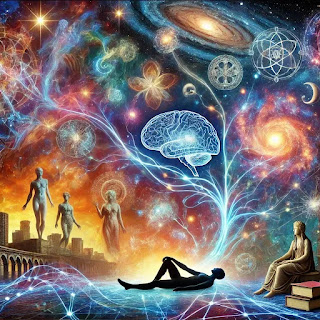Rapid Eye Movement (REM)
1. Sleep Cycle Overview
The human sleep cycle has several stages, classified into REM sleep and non-REM sleep. Non-REM sleep is divided into three stages (N1, N2, and N3), with each stage representing deeper sleep. After cycling through these non-REM stages, the brain moves into REM sleep.
2. Characteristics of REM Sleep
Eye Movements: During REM sleep, the eyes move rapidly back and forth under the eyelids, which is where the phase gets its name.
Dreaming: REM sleep is closely associated with dreaming. Most people report vivid, complex, and emotional dreams during this phase.
Muscle Atonia: The body experiences a state of paralysis, known as atonia, where muscles (except those used for essential functions, like breathing) become relaxed or inactive. This prevents acting out dreams.
Brain Activity: The brain becomes more active during REM sleep. In fact, it can resemble brain activity during waking hours, and this phase is often called "paradoxical sleep" because of the contrast between the active brain and inactive body.
Increased Heart Rate & Breathing: Breathing becomes more irregular, heart rate increases, and blood pressure may rise, similar to waking states.
3. Physiological Role of REM
Memory Consolidation: REM sleep plays an essential role in memory and learning. It helps the brain consolidate new information and experiences by transferring short-term memories into long-term storage.
Emotional Regulation: REM sleep is linked to emotional processing. Studies suggest that it helps reduce the emotional intensity of previous experiences, contributing to emotional resilience.
Brain Development: For infants and young children, REM sleep is crucial for brain development. Babies spend a much larger proportion of sleep in the REM stage compared to adults.
4. Cycles and Timing
A typical night includes multiple REM cycles, with each cycle getting progressively longer as the night progresses. The first REM phase may last only a few minutes, while later phases may last up to an hour. REM sleep usually takes place during the latter half of the sleep period.
5. REM Sleep Deprivation
Lack of REM sleep can impair cognitive functions like memory, decision-making, and emotional regulation. Over time, this deprivation could lead to mood disorders, including anxiety and depression. When people are deprived of REM sleep, their bodies will often enter it more quickly the next time they sleep, a phenomenon called "REM rebound."
6. Factors Affecting REM Sleep
Age: As people age, the amount of time spent in REM sleep decreases. Newborns spend about 50% of their sleep in REM, while older adults spend around 20%.
Medications: Certain medications, particularly antidepressants, can suppress REM sleep.
Sleep Disorders: Conditions such as sleep apnea, narcolepsy, and insomnia can disrupt REM sleep.
7. Role in Sleep Disorders
REM Sleep Behavior Disorder (RBD): People with this disorder act out their dreams because the normal paralysis during REM sleep is absent. This can lead to injuries to themselves or their sleeping partners.
Narcolepsy: Narcoleptic patients often enter REM sleep almost immediately after falling asleep, bypassing the non-REM stages, and may experience REM-like symptoms (e.g., vivid hallucinations) while awake.
Summary
REM sleep is vital for mental restoration, emotional health, memory, and learning. Its distinctive characteristics, such as rapid eye movements, dreaming, and muscle paralysis, make it a unique and critical component of the sleep cycle.





Comments